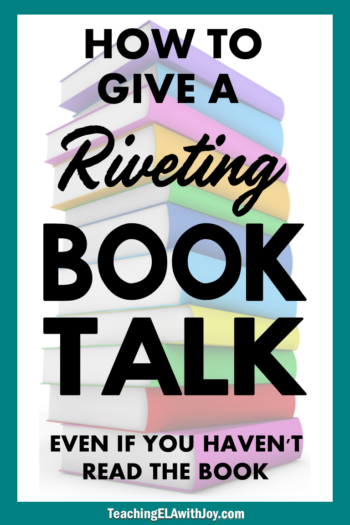Don’t you just love seeing students get excited when choosing books to read independently? One way you can spark that enthusiasm . . . give a book talk!
Sure, students can browse your class or school library looking at book covers and reading the blurbs. But what if you could entice them with book talks so awesome that students would be begging for more? Read on to discover how to give a super-engaging book talk, even if you don’t have time to read the whole novel.
Keeping a Book Talk Log
You’ll need someplace to keep notes on your book talks. That way you can refer to them and add to them year after year. Create a space on computer or just get a small, hard-copy notebook. That’s what I did when I started giving book talks back in 1996! Besides the title and author, I jot down some information about the main character’s situation that I want to tell students as I open the book talk. I also reference page numbers where I will read from the book.
Preparing for the Book Talk
Hopefully, you love devouring YA novels. But even if time prevents you from reading title after title, you can still be an expert with book recommendations. In order to prepare for a book talk, here’s what you do:
- Get a copy of the book either by purchasing or from your school library. You will need to read about 20-25 pages of the book. You probably know how quick this reading will go. These books are almost always that good!
- Now you must decide which specific parts would get kids interested and lead them to the edge of their seats. You’ll want to give your students some background first. Begin to underline (very lightly so you can erase later) sentences that “string together” a plot taking off that will pull them in. This is the “good stuff” that you will read aloud with lots of expression. You can skip areas of extra description or side plots. This re-reading shouldn’t take too long. Keep turning pages until you find that perfect place to begin. Combine dialogue and narration that moves the plot along to build suspense or tension. Students love this part of the book talk, so make sure you cover some good rising action and leave them hanging on a cliff!
- Remember the notes I said you’d need to keep? Write down the specific background information you think students will need to know before you begin reading anything from the book. That way, the parts you read aloud from the novel will make sense in their minds. Jot these notes in the form of short phrases.
As an example, for one of my very first book talks I used The Car, by Gary Paulsen. The book drew me in from the beginning, so I immediately started underlining everything. But as the plot got more enticing, I realized I could “sum up” a lot of the beginning pages and just quickly explain. I needed to get a little more into the book to choose my “read aloud” parts as the plot picked up. So I started underlining dialogue on page 9 when both of Terry’s parents separately announce they are leaving home. I then moved into pages 10-11, where we learn about the Bearcat, an unassembled car kit his father left behind in the garage. From there, I underlined the sentences or paragraphs that most revealed action, leaving others out. And of course I left my students with that cliffhanger! All in all, I probably read them the equivalent of three pages.
Here’s a picture of my “old-school” notes page for my book talk on The Car:

Giving the Actual Book Talk
You would be surprised how time flies when you give a book talk! What I mean is, if you choose too many sections from the book to read aloud, your book talk could end up longer than time allows. I like to mark two different places I could end. Then I have an option of lengthening or shortening the book talk.
Here’s how giving the book talk might look:
- It’s good to display the title and author and even the book cover on your whiteboard. Students will get a preview of what you’ll be book talking. Now hold the book up and tell students that you want to share today about this very intriguing novel! You might ask students if they have read any books by this author, or what their thoughts are after looking at the book’s cover.
- Now you are ready to give the name of the protagonist(s) and explain the background information (you have notes jotted for this) from the story’s opening pages.
- Next, in your most attention-getting voice, jump right in to reading the sections you underlined from the book’s pages. Take your time and play up the suspense, especially as you come to your ending.
That’s it! Now watch your students come forward asking to borrow the book! It’s a great idea to check with your school library in advance to see how many copies they might have. You’ll find students reaching out to the public library as well.
Have fun with all the wonderful YA books out there!
You might like these Student Response Activities for Independent Reading:

If you’d like ideas for a fun Book Pass with your students, click here: The Secret to a Great Book Pass







Leave a Reply